
14 crossword puzzles related to 7th grade science.
- Subject:
- Life Science
- Physical Science
- Material Type:
- Homework/Assignment
- Author:
- Share My Lesson Science Team
- Date Added:
- 06/11/2021

14 crossword puzzles related to 7th grade science.
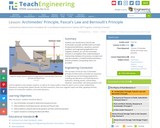
Students are introduced to Pascal's law, Archimedes' principle and Bernoulli's principle. Fundamental definitions, equations, practice problems and engineering applications are supplied. A PowerPoint® presentation, practice problems and grading rubric are provided.
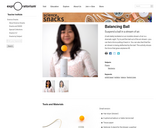
This webpage from Exploratorium provides an activity that demonstrates the Bernoulli principle with readily available materials. In this activity a table tennis ball is levitated in a stream of air from a vacuum cleaner. The site provides an explanation of what happens, asks questions about the activity, and also describes applications to flight. This activity is part of Exploratorium's Science Snacks series.

In this quick and simple activity, learners explore how the distribution of the mass of an object determines the position of its center of gravity, its angular momentum, and your ability to balance it. Learners discover it is easier to balance a wooden dowel on the tip of their fingers when a lump of clay is near the top of the stick. Use this activity to introduce learners to rotational inertia.

Tony Sarg was a puppeteer and marionette master who invented the first, larger than life, helium balloons for the annual Macy’s Thanksgiving Day Parade. The resource includes a lesson plan/book card, a design challenge, and copy of a design thinking journal that provide guidance on using the book to inspire students' curiosity for design thinking. Maker Challenges include: (1) Dash/Sphero: Develop a Macy’s Day Parade route using tape on the ground with a partner. Then, switch routes with another group and program the robot of your choice to navigate the parade route using code. (2) Ozobot: Develop a synchronized dance routine for both Ozobots for the stage of the Macy’s day parade using https://ozoblockly.com/editor (3) Create a moveable puppet that will be featured in the Macy’s Day Parade.
A document is included in the resources folder that lists the complete standards-alignment for this book activity.
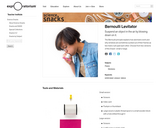
Demonstrate the Bernoulli Principle using simple materials on a small or large scale. This resource includes two activities that allow learners to experience the Bernoulli Principle, in which an object is suspended in air by blowing down on it. Use this activity to explain how atomizers work and why windows are sometimes sucked out of their frames as two trains rush past each other.

In this activity, a spinning bicycle wheel resists efforts to tilt it and point the axle in a new direction. Learners use the bicycle wheel like a giant gyroscope to explore angular momentum and torque. Learners can participate in the assembly of the Bicycle Wheel Gyro or use a preassembled unit to explore these concepts and go for an unexpected spin!
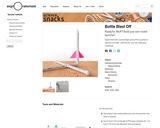
Experiment with rocket designs and a PVC launcher to discover how high—and how far—you can make your rockets go.

Here’s a new “spin” on an old toy. In this modern adaptation of a classic toy—the spool racer—a plastic water bottle is propelled by energy stored in a wound-up rubber band.

Using scrap metal and spare parts, William Kamkwamba created a windmill to harness the wind and bring electricity and running water to his Malawian village. The resource includes a lesson plan/book card, a design challenge, and copy of a design thinking journal that provide guidance on using the book to inspire students' curiosity for design thinking. Maker Challenge: Develop a way to harness the wind by designing with Strawbees.
A document is included in the resources folder that lists the complete standards-alignment for this book activity.
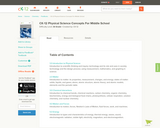
CK-12 Physical Science Concepts covers the study of physical science for middle school students. The 5 chapters provide an introduction to physical science, matter, states of matter, chemical interactions and bonds, chemical reactions, motion and forces, and the types and characteristics of energy.
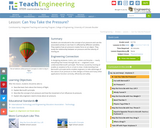
This lesson introduces students to the concept of air pressure. Students will explore how air pressure creates force on an object. They will study the relationship between air pressure and the velocity of moving air.
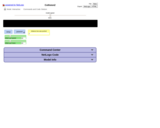
A simulation to model Newton's Laws through the collision of a cart and a box.
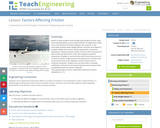
Based on what they have already learned about friction, students formulate hypotheses concerning the effects of weight and contact area on the amount of friction between two surfaces. In the Associated Activities (Does Weight Matter? and Does Area Matter?), students design and conduct simple experiments to test their hypotheses, using procedures similar to those used in the previous lesson (Discovering Friction). An analysis of their data will reveal the importance of weight to normal friction (the friction that occurs as a result of surface roughness) and the importance of surface area to the friction that occurs between smooth surfaces due to molecular attraction. Based on their data, students will also be able to calculate coefficients of friction for the materials tested, and compare these to published values for various materials.

Objective
SWBAT plan and carry out an investigation using science and engineering practices.
Big Idea
Welcome to the water park! Students will create a “lazy river” boat from aluminum foil that will hold the most passengers.
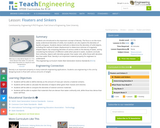
This lesson introduces students to the important concept of density. The focus is on the more easily understood densities of solids, but students can also explore the densities of liquids and gases. Students devise methods to determine the densities of solid objects, including the method of water displacement to determine volumes of irregularly-shaped objects. By comparing densities of various solids to the density of water, and by considering the behavior of different solids when placed in water, students conclude that ordinarily, objects with densities greater than water will sink, while those with densities less than water will float. Density is an important material property for engineers to understand.
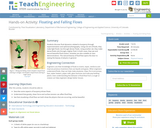
Students discover fluid dynamics related to buoyancy through experimentation and optional photography. Using one set of fluids, they make light fluids rise through denser fluids. Using another set, they make dense fluids sink through a lighter fluid. In both cases, they see and record beautiful fluid motion. Activities are also suitable as class demonstrations. The natural beauty of fluid flow opens the door to seeing the beauty of physics in general.

Forces arrow practice worksheet. Put the board truck on the whiteboard and get the kids to come up and draw on their answers around it. Answers are provided on a separate document.
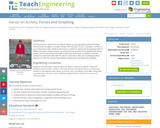
Use this activity to explore forces acting on objects, practice graphing experimental data, and introduce the algebra concepts of slope and intercept of a line. A wooden 2 x 4 beam is set on top of two scales. Students learn how to conduct an experiment by applying loads at different locations along the beam, recording the exact position of the applied load and the reaction forces measured by the scales at each end of the beam. In addition, students analyze the experiment data with the use of a chart and a table, and model/graph linear equations to describe relationships between independent and dependent variables.

A PowerPoint that includes 6 lessons to work on Forces and their effects.The PowerPoint is clearly cut into several lessons; with objectives; definitions; activities and directions for practicals.The handout that goes with one of the lesson is available.